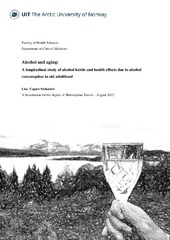| dc.contributor.advisor | Grønli, Ole K. | |
| dc.contributor.author | Stelander, Line Tegner | |
| dc.date.accessioned | 2022-11-23T08:05:14Z | |
| dc.date.available | 2022-11-23T08:05:14Z | |
| dc.date.issued | 2022-12-15 | |
| dc.description.abstract | Alcohol use is a leading risk factor for injuries, mortality and the burden of disease. Alcohol consumption among older adults varies considerably, depending on factors such as age, social class, education, ethnicity, time period and geographical setting. Furthermore, the health effects associated with alcohol consumption in old age are an under researched area. The overall aim of this thesis was to investigate trends in alcohol consumption among older adults (60 years or older) from the same geographical setting across 25 years, and any health effects due to alcohol consumption. Participants aged 60–99 when attending the Norwegian population-based Tromsø Study were followed for up to 25 years. The overall abstinence rate decreased considerably between 1994 and 2016, from 31 % to 11 %. The probability of reporting frequent drinking increased more among women compared to men (6-8-fold increase compared to 3-4-fold increase). The overall prevalence of at-risk drinking was equal in women and men in 2016; 44 % and 46 %, respectively. At-risk drinking was associated with very good health, living with a spouse or partner, and having adequate social support in women, while it was associated with the use of sleeping pills in men. We found that women, but not men, who consumed ≥ 100 g / week had better self-rated health than those who consumed < 100 g / week (OR 1.85, 95 % CI 1.46-2.34). Our findings indicate that women’s drinking patterns are approaching those of men. So far there is no definite evidence of increased mortality in the heaviest drinkers, as their balanced risk factors appear to be beneficial. Nevertheless, we conclude that our findings imply that a change in governmental strategies and alcohol policy to influence alcohol consumption among older adults should be considered. | en_US |
| dc.description.doctoraltype | ph.d. | en_US |
| dc.description.popularabstract | Alcohol use is a leading risk factor for injuries, mortality and the burden of disease. Historically, alcohol consumption has been very modest in older adults. However, alcohol consumption varies significantly depending on factors such as age, social class, education, ethnicity, time period and geographical setting. The overall aim of this thesis was to investigate trends in alcohol consumption among older adults from the same geographical setting across 25 years, and any health effects due to alcohol consumption. The analyses used a longitudinal design with data from participants aged 60 years or older when attending in the Norwegian population-based Tromsø Study. Alcohol consumption increased considerably from 1994 to 2016. The increase was greater among women than men, which indicate that women’s drinking patterns are approaching those of men. So far there is no definite evidence of increased mortality in the heaviest drinkers, as their balanced risk factors appear to be beneficial | en_US |
| dc.description.sponsorship | Helse Nord prosjektnummer: HNF 1467-19
Ph.d.-stipend | en_US |
| dc.identifier.uri | https://hdl.handle.net/10037/27485 | |
| dc.language.iso | eng | en_US |
| dc.publisher | UiT The Arctic University of Norway | en_US |
| dc.publisher | UiT Norges arktiske universitet | en_US |
| dc.relation.haspart | <p>Paper I: Stelander L.T., Høye, A., Bramness, J.G., Selbæk, G., Lunde, L.H., Wynn, R. & Grønli, O.K. (2021). The changing alcohol drinking patterns among older adults show that women are closing the gender gap in more frequent drinking: the Tromsø study, 1994-2016. <i>Substance Abuse Treatment, Prevention and Policy, 16</i>, 45. Also available in Munin at <a href=https://hdl.handle.net/10037/21776> https://hdl.handle.net/10037/21776</a>.
<p>Paper II: Stelander, L.T., Høye, A., Bramness, J.G., Wynn, R. & Grønli, O.K. (2022). Sex differences in at-risk drinking and associated factors-a cross-sectional study of 8,616 community-dwelling adults 60 years and older: the Tromsø study, 2015-16. <i>BMC Geriatrics, 22</i>, 170. Also available in Munin at <a href=https://hdl.handle.net/10037/24602>https://hdl.handle.net/10037/24602</a>.
<p>Paper III: Stelander, L.T., Lorem, G.F., Høye, A., Bramness, J.G., Wynn, R. & Grønli, O.K. The effects of exceeding low-risk drinking thresholds on self-rated health and all-cause mortality in older adults: The Tromsø study, 1994-2020. (Submitted manuscript). | en_US |
| dc.rights.accessRights | openAccess | en_US |
| dc.rights.holder | Copyright 2022 The Author(s) | |
| dc.subject.courseID | DOKTOR-003 | |
| dc.subject | VDP::Social science: 200::Psychology: 260 | en_US |
| dc.subject | VDP::Medical disciplines: 700::Health sciences: 800::Other health science disciplines: 829 | en_US |
| dc.subject | Tromsøundersøkelsen | en_US |
| dc.subject | The Tromsø Study | en_US |
| dc.title | Alcohol and aging: A longitudinal study of alcohol habits and health effects due to alcohol consumption in old adulthood | en_US |
| dc.type | Doctoral thesis | en_US |
| dc.type | Doktorgradsavhandling | en_US |


 English
English norsk
norsk